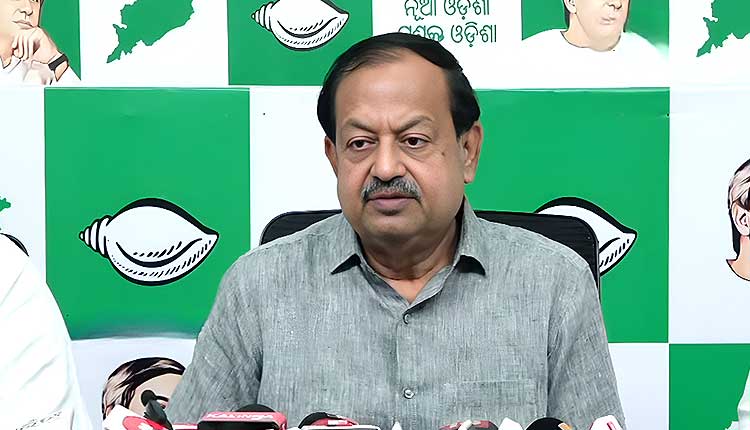Nuapada: The Biju Janata Dal (BJD) relied heavily on the strategic deployment of Senior Vice President Shri Debi Prasad Mishra to anchor its campaign and messaging in the high-stakes Nuapada by-election.
Facing internal challenges, notably the defection of key local figure Jay Dholakia, Mishra’s efforts were central to stabilizing the local unit and crafting an aggressive counter-narrative against the then-ruling Bharatiya Janata Party (BJP).
Shri Mishra’s strategic deployment focused primarily on two critical areas: validating the party’s non-local candidate selection and leading the political offensive against the opposition.
The BJD’s nomination of Smt. Snehangini Chhuria, a strong woman leader from Western Odisha but not a resident of Nuapada, immediately invited attacks on the ‘insider versus outsider’ front.
Shri Mishra took the lead in publicly defending this decision, effectively managing the narrative. He highlighted Chhuria’s deep, long-standing connections to the district, specifically referencing her maternal home in Nuapada and her previous extensive tenure as a District Observer for the party.
This move reframed the candidate’s status within a proven electoral history, supporting the BJD’s focus on selecting leaders of regional stature over strict local residency.
In line with the BJD’s overall strategy following the state elections, Shri Mishra acted as the chief proponent of an aggressive counter-messaging campaign.
He repeatedly attacked the BJP-led government with the “double destruction” narrative, alleging that the administration had failed to deliver on core welfare promises such as free electricity, pensions, and job creation during its tenure.
This allowed the BJD to successfully shift the campaign focus from internal organizational issues to the incumbent government’s performance deficits.
In the aftermath of the Dholakia family’s departure and heightened political rivalry, maintaining internal unity was paramount. Shri Mishra utilized consistent media engagement to project unwavering confidence and, crucially, to reinforce the BJD’s deep historical connection to the region.
Shri Mishra invoked the legacy of Legendary Statesman Shri Biju Patnaik, who carved out Nuapada as a district during his tenure as Chief Minister, giving a distinct identity to the backward region.
Furthermore, he highlighted how Biju Patnaik’s son, Shri Naveen Patnaik, scaled up development in Nuapada after becoming Chief Minister.
Most importantly, Shri Mishra reminded the public that Shri Naveen Patnaik had previously appointed Shri Rajendra Dholakia as a Minister in his Cabinet to pursue the developmental agenda—a powerful narrative used to counter recent defections.
This generation of the Biju Patnaik and Naveen Patnaik contribution narrative, which Shri Mishra skilfully amplified as an intelligent political strategist, was pivotal in aligning all local aspirants behind the official party mandate and significantly bolstering the BJD’s support in the by-poll.
Furthermore, Shri Mishra played a crucial role in crisis management. Following a controversial raid by election officials at the residence of BJD star campaigner Priti Ranjan Ghadei, Shri Mishra was swift to respond. He publicly condemned the action as politically motivated and an alleged misuse of administrative power by the ruling party.
This robust defence was vital for maintaining the morale of the grassroots workers and positioning the BJD as a victim of unfair political pressure, a move designed to garner public sympathy.
He reaffirmed the enduring legacy of Biju Patnaik and the popularity of BJD President Naveen Patnaik among the local populace. His public dismissal of any speculation regarding internal deals or factional conflicts related to the candidate selection process was effective in aligning all local aspirants behind the official party mandate, ensuring a unified campaign effort on the ground.


